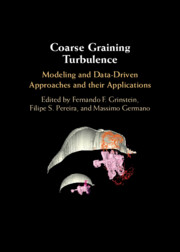Book contents
- Frontmatter
- Contents
- Contributors
- Prologue
- Part I Paradigms and Tools
- Part II Challenges
- 9 Transition to Turbulence
- 10 Wall-Bounded Turbulence
- 11 Scale-by-Scale Nonequilibrium in Turbulent Flows
- 12 Coarse-Graining in Multiphase Flows: From Micro to Meso to Macroscale for Euler–Lagrange and Euler–Euler Simulations
- 13 Coarse Graining for Thermal Flows
- 14 High-Order Simulations of Supersonic Combustion
- 15 Coarse-Graining Supersonic Combustion
- 16 Transition and Multiphysics in Inertial Confinement Fusion Capsules
- 17 Firestorms, Fallout, and Atmospheric Turbulence Induced by a Nuclear Detonation
- Epilogue
- Abbreviations
- Index
- References
14 - High-Order Simulations of Supersonic Combustion
from Part II - Challenges
Published online by Cambridge University Press: 31 January 2025
- Frontmatter
- Contents
- Contributors
- Prologue
- Part I Paradigms and Tools
- Part II Challenges
- 9 Transition to Turbulence
- 10 Wall-Bounded Turbulence
- 11 Scale-by-Scale Nonequilibrium in Turbulent Flows
- 12 Coarse-Graining in Multiphase Flows: From Micro to Meso to Macroscale for Euler–Lagrange and Euler–Euler Simulations
- 13 Coarse Graining for Thermal Flows
- 14 High-Order Simulations of Supersonic Combustion
- 15 Coarse-Graining Supersonic Combustion
- 16 Transition and Multiphysics in Inertial Confinement Fusion Capsules
- 17 Firestorms, Fallout, and Atmospheric Turbulence Induced by a Nuclear Detonation
- Epilogue
- Abbreviations
- Index
- References
Summary
Using high-order simulations, we have shed light on complex chemically reacting flow processes and identified new mechanisms of the supersonic combustion process. We have employed 11th-order accurate implicit large eddy simulation (ILES) in conjunction with a finite-rate (Arrhenius) thermochemistry model using a reduced reaction mechanism for the combustion of hydrogen and air. We compare the coarse-grained computations with available experiments from the German Aerospace Centre (DLR) and discuss the accuracy and uncertainties. A supersonic combustion chamber can be accurately modelled using high-order ILES without a specific turbulence-chemistry model. The simulations reveal that the flame intermittently propagates upstream behind the wedge-shaped flame holder, alternating between the upper and lower turbulent free shear layers at a frequency of ≃ 7,990 Hz. This can be a leading cause of unsteady pressure loadings on the interior surfaces downstream of the combustion chamber and is a crucial structural design parameter. Furthermore, the simulations reveal that high temperatures are sustained long distances downstream of the combustion onset. A barycentric map for the Reynolds stresses is employed to analyze the turbulent anisotropy. The results correlate the axisymmetric contraction and expansion of turbulence with the interaction of the reflected shock waves and the supersonic combustion hydroxyl production regions. The physics insights presented in this study could potentially lead to more efficient supersonic combustion and engineering designs.
- Type
- Chapter
- Information
- Coarse Graining TurbulenceModeling and Data-Driven Approaches and their Applications, pp. 419 - 454Publisher: Cambridge University PressPrint publication year: 2025

